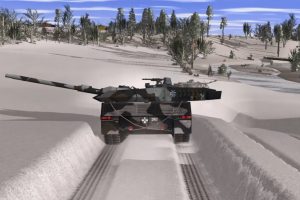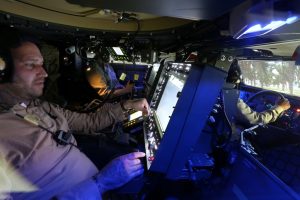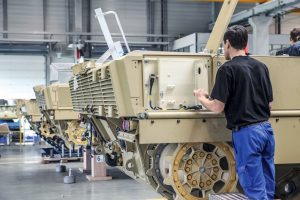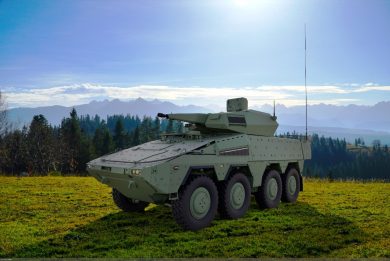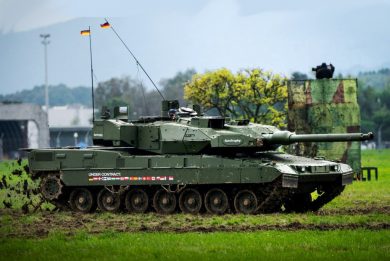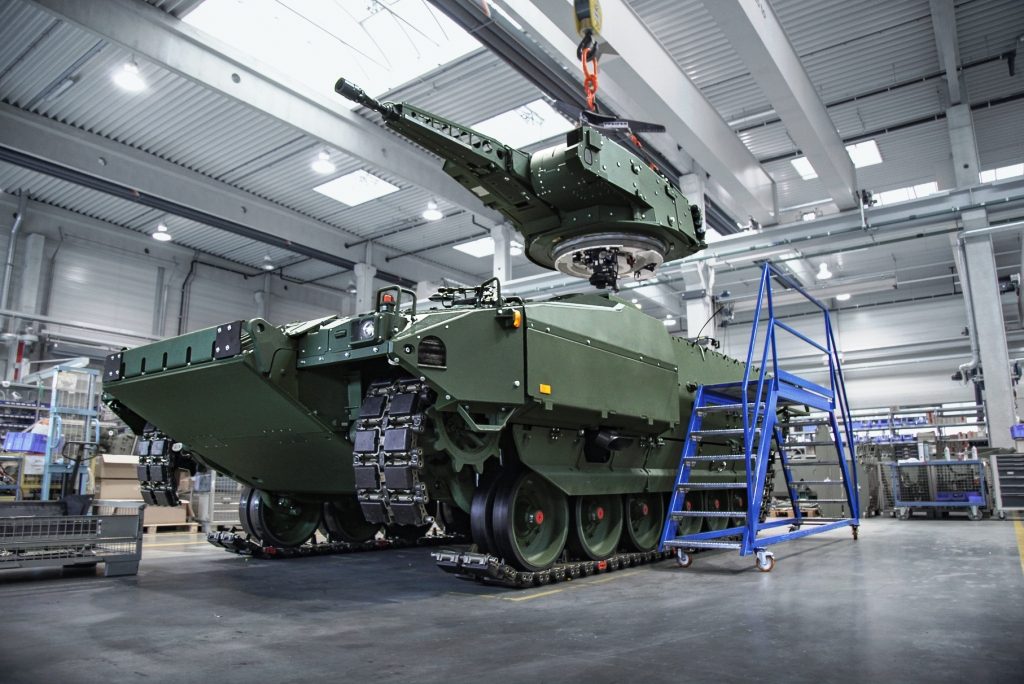
Krauss-Maffei Wegmann: increasing the group industrial base and designing a new IFV
By Paolo Valpolini
A Leopard 2 advances on the snowy terrain living a track in the white surface, followed by a second MBT that rolls over a more steady surface, the first tank having compacted the snow. An artillery shelling starts, destroying trees and houses of the nearby village that has to be crossed by the Leo 2s. A first attempt to move aside the wreck of a vehicle shows that more energy is needed to free the street; the driver exploits the 1,500 hp available and rolls ahead his tank, freeing further debris that he finds along the road. All this happens in the Krauss-Maffei Wegmann (KMW) hall dedicated to simulation systems, at the company headquarters in Munich.
The facility is encumbered with fully realistic cabins, the turret ones also simulating the loader’s position, dummy rounds allowing to train the full crew, the driver’s cabin being linked to that of the turret. While hardware is as close as possible to reality, the same is true for virtual training; the Gunnery and Combat Simulation Software Suite reproduces physical behaviour with a high degree of fidelity, exploiting rigid-body dynamics, which allow representing systems movements of interconnected bodies when submitted to external forces, while damage and collision effects are calculated in real time. Reality also applies to the deployment on the virtual battlefield, the software ensuring the autonomous and intelligent behaviour of computer generated forces, software agents being controlled by Artificial Intelligence. It also contains an Order of Battle editor and allows easy integration of OEMs C4I systems. Networking more than one tank, as well as tank simulators with other types of simulators located elsewhere is of course feasible, the main issue being the availability of an adequate network infrastructure. In the recent past KMW provided training centres to Greece, Chile, Sweden, Qatar, and is working on that for Hungary that will be finalised by 2024 and will include Leopard 2A7+ and PzH 2000 simulators, as well as company and battalion level commander stations and forward observer/air controller stations.
While in the new hall dedicated to bridging systems Leguans are being installed on Leopard 2 chassis, in the other halls along Krauss-Maffei Straße, in the northern part of Munich, it is possible to see numerous armoured vehicles in their last phase of assembly, among them Leopard 2s ready to be delivered to Hungary, Pumas for the Bundeswehr, Boxers for Lithuania, and so on.
While this is today reality, the German company is looking ahead to new technologies and new potential contracts, adding not only new products but also widening its industrial base. Now part of KNDS together with Nexter of France, the Munich-based group is not anymore solely an armoured vehicles manufacturer, but has considerably expanded its scope.
An expanding group
Today the core of KMW, is in Munich (headquarters) and Kassel, with facilities in Mainz, mostly devoted to bridges, and in Kölleda, some 80 km west of Leipzig, devoted to maintenance programmes, total over 3,000 employees, the overall Group workforce being between 4,100 and 4,500.
In 2016 KMW acquired Battle Tank Dismantling GmbH; BTD is based in Rockensußra, some 200 km north-east of Frankfurt, and is specialized in the demilitarization, recycling and disposal of defence material. According to KMW it is the only European company certified for the whole DEMIL process of military vehicles.
In December 2014 KMW acquired Diehl Defence Land System´s GmbH; based in Remscheid, 25 km east of Düsseldorf, the company is active in tank tracks and suspensions production. The track side of the company is now known as Defence Service Tracks GmbH (DST) and is designing and manufacturing steel tracks as well as segmented or endless rubber tracks. As part of the same deal, KMW got hold of Defence Service Logistics GmbH (DSL) which is active in the maintenance, repair and overhaul (MRO) business, not only of KMW equipment as a good share of its workload comes from the maintenance of US Army Europe vehicles and equipment. The company is expanding, adding new buildings in its facility at Freisen, some 100 km south-west of Frankfurt, close to the French border, MRO becoming more and more a lucrative business in the defence field.
Based in Hamburg, KMW Schweißtechnik (KMWS) is KMW’s competence centre for armoured steel processing. It manufactures vehicle hulls and housings from special steels thanks to its high quality welding capabilities and its state-of-the-art testing facilities.
In Germany KMW is involved in two joint ventures. In 1999, together with Rheinmetall Military Vehicles GmbH and Stork PWV B.V. (now Rheinmetall Defence Nederland B.V.), KMW formed ARTEC GmbH, based in Munich, which is the home of the Boxer 8×8 armoured vehicle. The second one, established in 2002, is PSM Projekt System & Management GmbH, a 50/50 JV with Rheinmetall Landsysteme GmbH, which is the home of the German Army Puma infantry fighting vehicle.
Internationally, since 2015 KMW is part of KNDS, the Franco-German alliance formed together with Nexter of France. In the mid 2010s these two nations have launched the Main Ground Combat System (MGCS) project aimed at providing a replacement for German Leopard 2 and French Leclerc main battle tanks. To this end in December 2019 KMW, together with Nexter Systems and Rheinmetall AG, established an ARGE (Arbeitsgemeinschaft, or working group) to pursue the development of the programme.
Krauss-Maffei Wegmann also features numerous subsidiaries worldwide, in the UK, the US, Brazil, Greece, Singapore, Qatar and Hungary.
In late May 2021 KMW announced the acquisition of 24.9% of the stakes of Milrem Robotics, the Estonian company specialised in unmanned ground vehicles. Although no comments were made on the aims of this move, it is foreseeable that KMW looks at Milrem Robotics as a strategic partner whose knowledge in autonomous systems could be applied to bigger systems, such as those part of the KMW portfolio, allowing the company to produce optionally-manned or unmanned systems in a relatively short development cycle.
A privately owned company, KMW does not publishes an annual report with its financial figures. However a recent press release by KNDS called for a 3.3 billion Euro of order intakes in 2020, which brings the consolidated order backlog to 10.6 billion Euro, revenues being 2.4 billion Euro, the combined Franco-German workforce totalling 8,270 employees.
A new tracked infantry fighting vehicle
Although not much is said on that subject at the KMW HQ, a new product is in full development; considering the number of Infantry Fighting Vehicles (IFVs) that have to be replaced in the coming years in Europe and worldwide, the company has launched a programme aimed at a new IFV based on innovative concepts. EDR On-Line understood that the secrecy around the project is mostly due to the fact that a key element in the programme is its openness towards collaborations with foreign parties in order to ease customers nations industries participation. At least two nations in Europe are seeking a new IFV. One of them is Italy, which in December 2020 organised an industry day on “A new generation armoured combat infantry system for infantry”. Beside typical considerations, the service stressed the importance of modularity, the mission module concept being a key issue, as well as unmanned systems integration, multinational cooperation and growth potential. Currently equipped with the Dardo in the combat and antitank versions, no further specialised versions were acquired although prototypes were developed, the Italian Army wants to provide its mechanised infantry battalions with a family of vehicles based on the same chassis, combat, antitank, mortar-carrier, command post, engineer, SHORAD, medical evacuation, recovery and ammunition carrier versions being part of the requirement. Some of the versions, i.e. the engineer, SHORAD and ammunition carrier, will be provided to combat support (artillery, engineers) and combat service support units part of the two heavy brigades, the “Ariete” armoured and the “Garibaldi” mechanised.
What EDR On-Line understood in the talks in Munich is that KMW aims at a fully open architecture, modularity being not only aimed at mission modules rapid replacement, something the company has learned well with the Boxer programme. The experience acquired with the Boxer programme, as well as that obtained with the German Puma IFV programme, the two systems being developed respectively as part of the ARTEC and the Puma joint ventures, is of course a key factor in the new IFV development.
Coming to the nearer future, artillery, the Leopard 2 evolution and future Boxer developments are the main topics on the play-table. These will be analysed in the coming articles.
Photos courtesy Krauss-Maffei Wegmann

